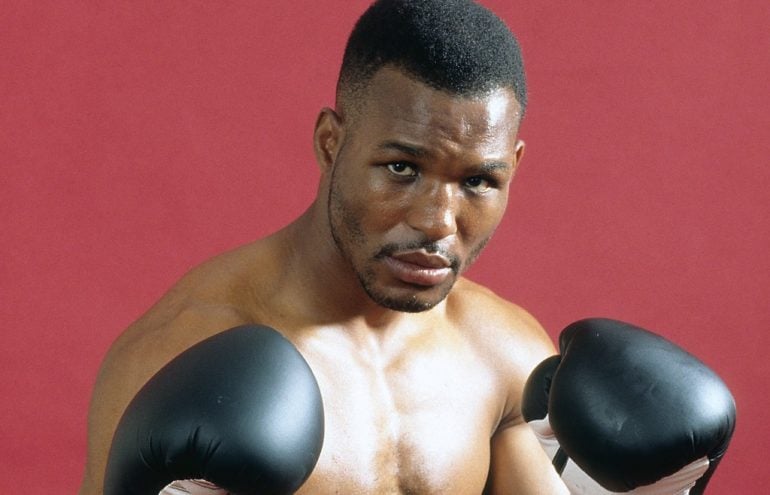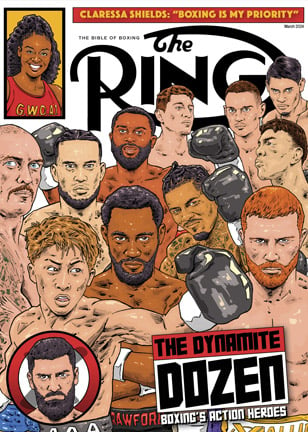Best I Faced: Bernard Hopkins

Few would have predicted early in Bernard Hopkins’ career that the former resident of Graterford Penitentiary would go on to become one of the finest middleweights in boxing history.
The second-oldest of eight children, Hopkins was born in Philadelphia, Pennsylvania, on January 15, 1965. He grew up in the notorious North Philadelphia area and quickly became a product of his environment.
“It was tough, it was challenging across the board,” Hopkins told The Ring. “You had to defend right and wrong. You had to always be on guard for everything – a stray bullet, getting robbed, or you become the robber.
“There were things you had to overcome, mentally, before it came to you, and then you had to survive. It wasn’t peaches and cream like the suburbs, every day was survival mode.”
Hopkins was first introduced to boxing as a nine-year-old. His uncles had boxed in the 1960s and 70s, so it was natural progression.
“It’s in my DNA,” said the former two-weight world champion. “I got introduced to it because everybody in North Philly used to fight. Fighting was like people playing chess in the park.
“I was good as a street fighter more than I was in the ring.”

September 2011 cover
Hopkins, who left school in the eighth grade, estimates that he had around 60 amateur fights. Nicknamed “Heads”, he was in and out of trouble from the age of 14, spent time in reform school, and at the age of 17 he was sentenced to 18 years in a penitentiary.
“Automatically you had to go and establish [yourself] amongst real bad guys and killers,” Hopkins recalled. “You are respected based on your first incident. Your first action must send a statement to everybody else. I didn’t wait for it to come to me. I challenged the baddest guy on the block and that got me respect from everybody else. I didn’t win but I didn’t lose.
“I had to establish that I was as crazy as anybody else in here. The future’s not something I plan on seeing anyway – that was the way I was.”
After five years in prison, Hopkins was released. He spent nine months in a halfway house and worked as a roofer.
Hopkins turned professional in October 1988 and dropped a four-round decision to Clinton Mitchell at light heavyweight. He didn’t box again for 16 months.
“It took that much time to meet Bouie Fischer,” he explained. “and to get down in weight, restructure my mind, and decide whether I really want to do this or not.”
He returned as a middleweight and won his next 22 fights before facing Roy Jones Jr. for the vacant IBF crown. That contest ended in his second defeat, but Hopkins quietly went about building his craft and won the vacated title two years later.
The self-styled “Executioner” would go on to unify all the major titles and become the undisputed middleweight king, surpassing Carlos Monzon’s legendary mark of 14 title defenses with 20 of his own. He also became the longest reigning 160-pounder in history with an incredible run of 10 years and two months. During that time, he impressively turned back the challenges of Glen Johnson (TKO 11), Keith Holmes (UD 12), Felix Trinidad (TKO 12), William Joppy (UD 12) and Oscar De La Hoya (KO 9).
After losing two questionable decisions to Jermain Taylor, B-Hop headed to 175 where he upset younger rivals such as Ring Magazine and lineal champion Antonio Tarver, Winky Wright and Kelly Pavlik. He became the oldest man to capture a world title when he beat Jean Pascal at age 46 in 2011, and later extended his own record by outboxing Beibut Shumenov to unify the IBF and WBA titles at the age of 49.
Hopkins, who was The Ring Magazine Fighter of the Year for 2001, took part in an incredible 33 world title bouts across three decades. His almost pathological zest for training marks him as perhaps the last of a dying breed. He retired aged 51, with a record of 55-8-2 (32 knockouts) after being stopped for the only time in his Hall of Fame career by Joe Smith Jr.
Hopkins, now 55, is married, has two daughters, lives in Delaware and is a partner in Golden Boy Promotions.
A documentary entitled “Bernard Hopkins’ Greatest Fight”, which revolves around the former champion’s life and times, has been directed by former HBO Sports creative director Christian Winters and could potentially have a big-name Executive Producer. That feature will hopefully be released next year, but the team were kind enough to share this short video.
He graciously took time to speak to The Ring about the best he fought in 10 key categories.
BEST JAB
Oscar De La Hoya: That’s why I stayed away from it. You know what was special about it? He threw it! No, he had a good jab. Seriously, I had to get past it to go to the ribs.
BEST DEFENSE
Winky Wright: He’s known for it. I called him the turtle, ’cause when a turtle feels danger, he sticks his head in and he’s safe until he sticks it out.
FASTEST HANDS
De La Hoya: I think De La Hoya was a little lighter in weight and he’s more of a combination puncher, so he was fast. Roy was fast but he was more of a one-or two punch (fighter), unless he got you hurt and then he’d do all that fast stuff. But De La Hoya was a combination puncher with speed. Joe (Calzaghe) had a lot of speed. He was one of those guys, he threw punches … they weren’t meaningful, powerful punches but he threw enough. I always joke and say about Joe, it’s like when you walk through a beehive and they’re all around you and sting you, there’s so many stinging you to a point they overwhelm you and you just run. Anybody that’s been stung by bees you try to knock off one or two then you just run out of there.
BEST FOOTWORK
De La Hoya: I had to chase De La Hoya down. He came up from junior middleweight, he was the smaller guy, I was the bigger guy and by him being smaller and moving it went nine rounds. I had to make him fight, smother him until I got the shot in.
SMARTEST
Roy Jones Jr.: He was smart enough to neutralize my best weapons and smart enough to not get hit by my big shots. Even though I got my shots in he wouldn’t get hit by more than one. Like if I got one in … and that’s the thing about fighting unique guys … if a guy lands that one shot, normally there’s another coming behind that. If one misses, there’s more coming. That’s like money. So, Roy was one of those guys if you hit him once, take that and run with it. If you got him three times, ohhh, my god! You saw what Antonio Tarver did to him, or Glen Johnson. Even though it was later, it tells you if you get him more than once you can get him out of there.
STRONGEST
Tavoris Cloud: He was a bull, but he wasn’t smart. That’s why I had to be the matador.
BEST CHIN
Robert Allen: We fought three times and he went the distance three times and I nailed him a couple of times and he looked at me. But he’s a tough Marine, so no surprise. But he has an iron chin.
BEST PUNCHER
Antwun Echols: He was clubbing, not swift. Thumping. Also, Felix Trinidad, but that’s all. He was really one dimensional. He had great success fighting one-dimensional people. … That’s not a knock on him but when you run into a Bernard Hopkins, who’s more than one dimensional, then you got a problem. Kovalev was a big puncher but I’m going to stick with Antwun Echols, he could crack.
BEST BOXING SKILLS
Jones: He was an all-around thing – best boxer, best defense, offense.
BEST OVERALL
Jones: Early career Roy Jones Jr. – speed, reflexes, unorthodox, that type of thing. No one, no one would have beat Roy Jones at that level, where he was at right there and then.
Questions and/or comments can be sent to Anson at [email protected] and you can follow him on Twitter @AnsonWainwright
READ THE MARCH ISSUE OF THE RING FOR FREE VIA THE NEW APP NOW. SUBSCRIBE NOW TO ACCESS MORE THAN 10 YEARS OF BACK ISSUES.















